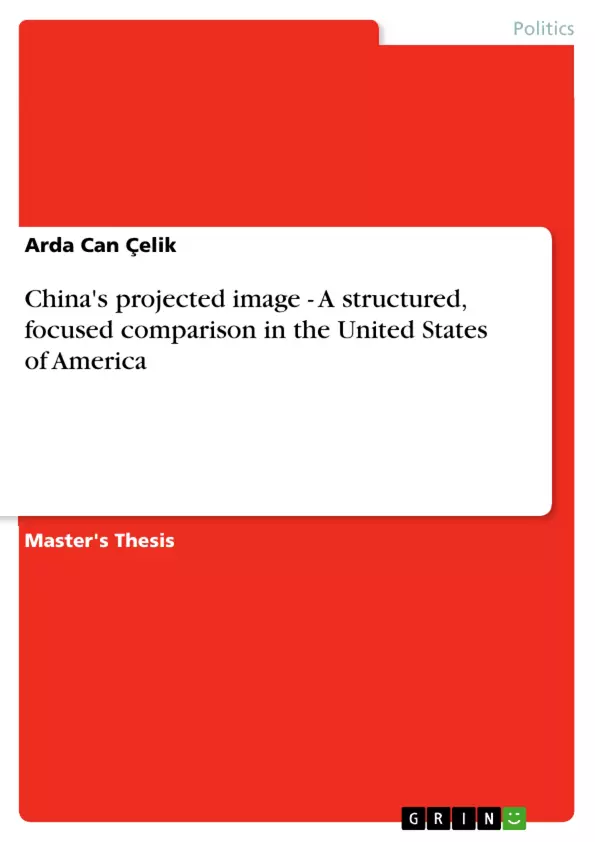This study provides an examination about China’s projected image and explores how China implements various concepts and channels for image building activities. It also displays the reasons and motivation points of image projection as a national policy. This national policy gives a reference to Chinese grand strategy which is embodied in Chinese Soft Power. Bearing this in mind; the study provides an explanation about the sources of projected image.
In order to follow the right track, the study primarily establishes an internal examination within China thereafter it explores the projection process within the U.S case. This approach enables to understand the changing U.S views of China and also pursues to find the dynamics of U.S public perception. In regards to the analysis; the study examines the Chinese efforts which try to build a favourable image in the minds of Americans. This process leads the study to explore the tools for the projected adjustment. It displays that; which implementations took place to affect the U.S society.
Furthermore, the study gives the reasons of Chinese PR and PD engagements which indicate the possible rewards for Chinese Power. This dimension targets to re-design the public perceptions which are also embodied in Beijing’s charm offensive. Thus China aims to fill the gap between her comprehensive power capacity and the concept of soft power.
Inhaltsverzeichnis (Table of Contents)
- I. Introduction
- 1.1. Research Question
- 1.2 Purpose and the Structure of Research.
- II. Literature Review and Research Gaps..............
- III. Research Design............
- IV. Theory........
- 4.1. Soft Power.
- Section 1..............
- 1.1 Image
- 1.2 Chinese Self Image.........
- 1.3 Chinese Existing Image in the United States
- 1.4. China Threat Theory.
- Section 2
- 2.1 Projected Image.
- 2.2 China's Projected Image .......
- Section 3.....
- 3.1 Sources of Projected Image…..\li>
- 3.1.1 Public Diplomacy ..
- 3.1.2 PR....................
- 3.2 Chinese Public Diplomacy.
- 3.3 Chinese PR strategies ....
- Section 4........▪▪▪▪▪▪▪▪
- 4.1 Effectiveness of Chinese Projected Image
- 4.1.1 Analysis of BBC (GlobeScan and PIPA)'s Results.
- 4.1.2 Analysis of Pew Research Centre's Results .......
- 4.1.3 Analysis of Anholt-GfK Roper Nation Brands Index.
- 4.2 Comparison and Final Analysis .......
Zielsetzung und Themenschwerpunkte (Objectives and Key Themes)
This master's thesis explores how China attempts to project its desired image in the United States. The study delves into the strategic motivations behind China's image-building efforts, examining the communication models, public diplomacy, and public relations strategies employed by the Chinese government. The study also assesses the influence of various factors on American public opinion regarding China.
- China's strategic concerns and motivations for projecting its image in the US.
- The methods and tools used by China to shape public perception in the US.
- The role of communication models, public diplomacy, and public relations in Chinese image building.
- The impact of China's image projection efforts on US public opinion.
- The interaction between China's image projection and various factors influencing US public perception.
Zusammenfassung der Kapitel (Chapter Summaries)
- Introduction: This chapter sets the stage for the thesis by discussing the changing concept of power in the post-Cold War era and how China's rise to prominence has created both opportunities and challenges. The chapter highlights the complex relationship between China and the United States, characterized by both cooperation and competition, and introduces the central research question: how does China try to project its ideal image in the United States?
- Literature Review and Research Gaps: This section reviews existing literature on China's image projection, identifying key concepts, theories, and previous research findings. It also highlights gaps in existing research that the present study aims to address.
- Research Design: This chapter outlines the methodology employed in the study, including data collection methods, research strategies, and analytical frameworks used to examine China's image projection efforts.
- Theory: This chapter delves into the theoretical framework underpinning the study, exploring the concept of soft power and its relevance to China's image projection strategy. It examines how China aims to leverage its image to achieve its political and economic goals.
- Section 1: This section focuses on China's self-image and how it is perceived by the outside world. It examines the existing image of China in the United States, exploring the "China Threat Theory" and its potential impact on Chinese image projection.
- Section 2: This section explores the concept of projected image and analyzes China's strategies for shaping its desired image in the US.
- Section 3: This section examines the sources of China's projected image, focusing on the roles of public diplomacy and public relations. It analyzes Chinese public diplomacy initiatives and PR strategies used to influence US public opinion.
- Section 4: This section assesses the effectiveness of China's image projection efforts, examining data from various surveys and analyses. It examines how China's image is perceived in the US and evaluates the success of its image-building initiatives.
Schlüsselwörter (Keywords)
The primary keywords and focus topics of this thesis include China's image projection, soft power, public diplomacy, public relations, US public opinion, China-US relations, strategic communication, national image, and international relations. The study explores the interplay of these concepts in understanding how China seeks to shape its image in the United States.
- Arbeit zitieren
- Arda Can Çelik (Autor:in), 2011, China's projected image - A structured, focused comparison in the United States of America, München, GRIN Verlag, https://www.grin.com/document/175201



